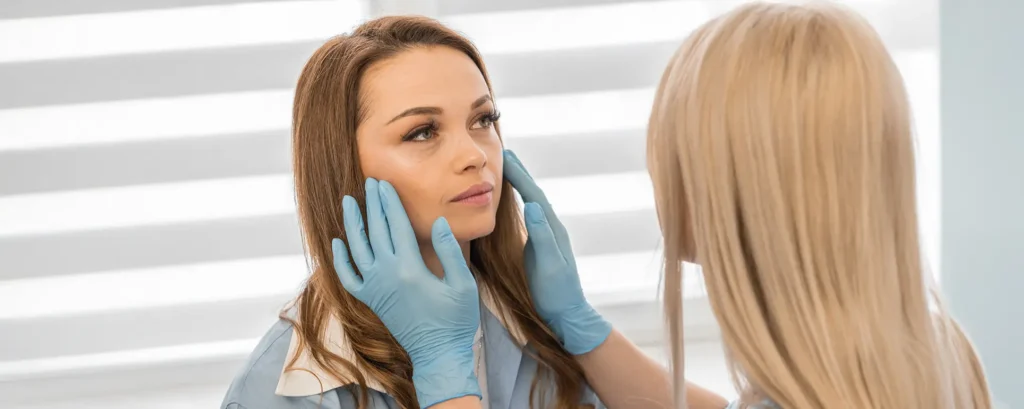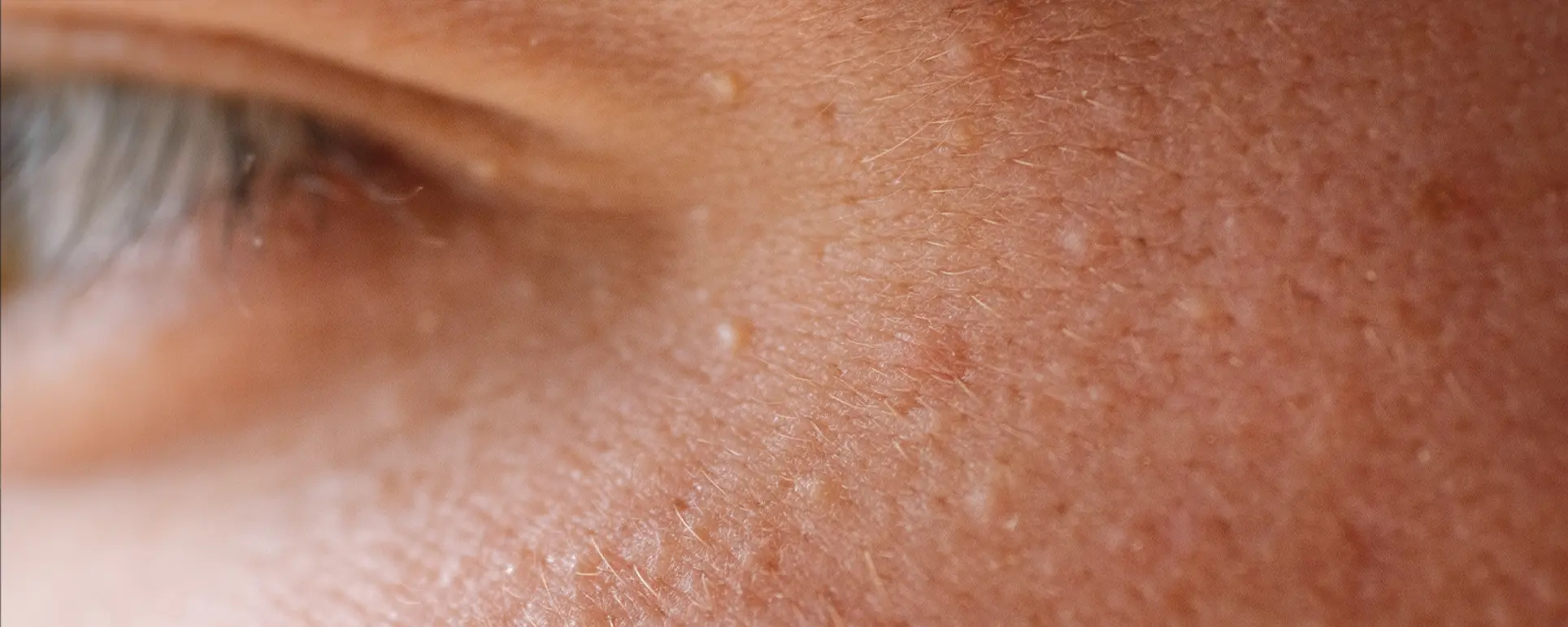You wake up one morning, head to the bathroom, and suddenly notice tiny, hard, white bumps clustered around your eyes, cheeks, or even along your nose. At first, you might think it’s nothing maybe a few leftover pimples or some dirt but then you realise they aren’t going away. No matter how much you cleanse, scrub, or exfoliate, these little bumps stubbornly stay put. What you’re seeing are called milia, and they can feel pretty frustrating, especially when your skin has been completely clear for years.
So, why do milia seem to appear out of nowhere? You might be wondering if you did something wrong, or if your skincare routine is suddenly to blame. The truth is, milia form when keratin a natural protein found in your skin gets trapped just beneath the surface. This creates those small, pearly bumps that don’t hurt, but definitely make your skin texture feel uneven. They’re completely harmless, but seeing them pop up all of a sudden can leave you scratching your head.
If you’ve been healthy, your skin has been smooth, and your routine hasn’t changed much, getting milia can feel like an unwelcome surprise. But the good news is, understanding why they appear can help you figure out what might be triggering them. Sometimes it’s something as simple as a change in your skincare products, a reaction to sun damage, or even just how your skin naturally renews itself as you get older.
In this guide, I’m going to walk you through the most common reasons milia show up suddenly, how your lifestyle or skincare habits might be contributing, and what you can do to manage or prevent them safely. By the end, you’ll have a much clearer idea of why your skin is acting up and how to get back to smooth, bump-free skin without making things worse.
What Are Milia?

Milia are those tiny, stubborn bumps that suddenly appear on your skin small, white or sometimes yellowish cysts that sit just under the surface. At first glance, you might mistake them for spots, blackheads, or regular acne, but they’re actually something quite different. Unlike pimples, milia aren’t caused by clogged pores or bacteria. Instead, they’re little pockets of trapped keratin, the natural protein in your skin that helps keep it strong and healthy.
If you touch them, you’ll notice they feel firm and don’t pop like pimples do. That’s because your usual acne-fighting creams, scrubs, or spot treatments won’t work on milia. You might even feel tempted to squeeze them but doing so can irritate your skin or make them worse, rather than helping.
Milia tend to show up in certain areas more often, including:
- Your cheeks, where the skin is delicate and smooth.
- Around your eyes, especially the lower eyelids.
- The forehead, which can be prone to skin stress from sun or skincare products.
- The nose, where the skin’s natural oils and structure make keratin more likely to get trapped.
Even though milia are completely harmless and don’t pose any health risk, their sudden appearance can be frustrating especially when they show up in places you can see every day. You may find yourself trying to cover them with makeup, only to notice they still stand out, making you wonder why your skin suddenly decided to develop them.
Understanding what milia actually are is the first step toward dealing with them safely and preventing them from coming back, without resorting to harsh treatments that won’t work.
Why Am I Getting Milia All of a Sudden?
If you’ve noticed milia popping up seemingly out of nowhere, you’re not alone. There are several common triggers that can explain why your skin suddenly develops these tiny bumps many of which might surprise you.
1. Skincare Habits
One of the main reasons you might suddenly get milia is heavy or unsuitable skincare. Thick creams, oil-based products, or makeup that isn’t completely removed can trap dead skin cells and keratin beneath the surface. If you’ve recently switched moisturisers, started using a richer sunscreen, or layered on heavier products, this could be why those little bumps are appearing.
2. Sun Damage
Years of sun exposure can change the structure of your skin. Over time, UV rays thicken and damage the outer layer, making it harder for dead skin cells to shed naturally. When this happens, keratin can get trapped, forming milia. Sometimes, you may notice a sudden outbreak after a sunny holiday or weekend, when your skin has been exposed to stronger UV rays than usual.
3. Natural Ageing
As you get older, your skin’s renewal process slows down. Dead skin cells tend to stick around longer, which increases the likelihood of them becoming trapped beneath the surface. This is why many people notice milia becoming more frequent in their 30s, 40s, and beyond.
4. Genetics
Sometimes, it’s simply in your DNA. If your parents or siblings regularly get milia, you might be more prone to them as well. Lifestyle tweaks can help reduce their frequency, but if genetics are at play, you may never be completely milia-free.
5. Trauma or Skin Damage
Milia can develop after skin trauma. Burns, rashes, or aggressive treatments like chemical peels, laser therapy, or microneedling can sometimes trigger “secondary milia.” These usually appear around the site of injury or irritation, showing up a few weeks after the skin has healed.
6. Medications
Certain medications, especially long-term steroid creams used for eczema or other skin conditions, can increase your risk of milia. If you’ve recently started a new treatment, it might be causing these bumps to appear.
7. Poor Exfoliation
Even if your skincare routine is otherwise solid, skipping exfoliation can allow dead skin cells to build up. Without regular removal, keratin can get trapped, leading to milia. This is especially common if you’ve stopped using chemical exfoliants or switched to gentler routines without introducing other methods to help your skin shed naturally.
8. Stress and Lifestyle Factors
While stress alone doesn’t directly cause milia, it does affect your overall skin health. Poor diet, lack of sleep, and high-stress periods can slow down your skin’s renewal process, creating the perfect environment for milia to form. So, if you’ve been going through a particularly stressful time lately, your skin might be reflecting it in the form of these stubborn little bumps.
Are Milia Dangerous?

The good news for you is that milia are completely harmless. They won’t turn into skin cancer, they’re not contagious, and they won’t cause any damage to your overall health. In most cases, they’re simply a cosmetic concern a little annoying, but nothing to panic about.
That said, it’s still important to pay attention to your skin. Milia can sometimes look similar to other spots or skin conditions. If you notice a bump that changes quickly, looks irregular, bleeds, or becomes painful, it’s always best to get it checked by a dermatologist. This way, you can be sure it’s nothing serious and rule out other conditions that might require medical attention.
In short, while milia themselves aren’t dangerous, staying alert and knowing what to watch for helps you take care of your skin safely.
How Long Do Milia Last?
You might be wondering how long these little bumps will stick around. The truth is, it can vary quite a bit. Sometimes, milia disappear on their own after a few weeks or months, especially if they were triggered by something temporary like minor skin irritation or a new skincare product. Your skin just needs time to naturally shed the trapped keratin.
In other cases, milia can linger for years if they aren’t treated professionally. This is more likely if they’re caused by genetics, ageing, or chronic skin conditions. Your skin type, lifestyle, and how you care for your skin can all influence how quickly milia go away.
While it might be tempting to try and pop them yourself, remember that squeezing or picking won’t make them disappear faster and can actually lead to irritation, scarring, or infection. If you want faster results or if the bumps bother you cosmetically, a dermatologist can safely remove them with simple procedures.
So, while milia aren’t permanent in every case, how long they stick around really depends on you, your skin, and the underlying cause. Patience or professional help is often the key.
Why You Shouldn’t Remove Milia Yourself
Because milia look like whiteheads, many people try to squeeze or pop them. Unfortunately, this doesn’t work.
- They’re too deep. Milia sit under the skin, so squeezing rarely dislodges them.
- You risk infection. Using needles or unsterile tools can introduce bacteria.
- You can scar. Especially around the eyes, DIY removal can leave marks.
That’s why dermatologists always recommend professional treatment instead.
Safe Treatments for Milia
If your milia aren’t disappearing on their own, or if they’re starting to bother you, there are several safe and effective treatments that a dermatologist can offer. The key is to avoid trying to remove them yourself at home, because that can irritate your skin or even cause scarring.
Professional Extraction
One of the most common solutions is professional extraction. Here, a dermatologist uses a sterile needle or tiny blade to make a small incision and gently remove the trapped keratin. The procedure is quick, precise, and has minimal risk of scarring. If you want expert care, visiting a milia removal clinic in London ensures the process is done safely and effectively, giving you smooth skin without the worry of complications.
Chemical Peels
Light chemical peels are another option. These treatments encourage your skin to shed dead cells and turn over more quickly. Over time, this can help prevent new milia from forming while gradually improving the texture of your skin.
Laser Therapy
For stubborn milia, or clusters that won’t go away, laser therapy can be highly effective. It targets the cysts precisely without harming the surrounding skin, making it a reliable choice for more persistent cases.
Topical Retinoids
If you prefer a treatment you can apply at home under guidance, prescription-strength retinoid creams are excellent. They speed up cell turnover, helping to reduce the likelihood of future milia. Retinoids take time to show results, but they’re great for prevention and maintaining smooth skin in the long term.
Cryotherapy
In some cases, dermatologists may use cryotherapy, which involves freezing the milia with liquid nitrogen. This is less common but can be effective for certain stubborn bumps.
By choosing professional treatments instead of DIY methods, you can clear your milia safely and reduce the chance of them coming back. Your dermatologist can help you decide which option is best based on your skin type, the location of the milia, and how persistent they are.
Preventing Milia
While you can’t always stop milia from forming completely, there are several habits you can adopt to reduce your chances of sudden outbreaks and keep your skin looking smooth.
- Cleanse thoroughly every night: Make sure you remove all makeup, sunscreen, and daily grime before bed. Leaving residue on your skin can trap keratin and increase the risk of milia.
- Avoid heavy creams around the eyes: Thick, rich products may feel luxurious, but they can clog pores in delicate areas like your eyelids and under-eyes. Opt for lightweight, gentle formulations instead.
- Exfoliate gently: Using mild chemical exfoliants, such as AHAs or BHAs, helps your skin shed dead cells naturally. This keeps keratin from getting trapped and forming bumps.
- Apply sunscreen daily: Sun damage can thicken your skin and make it harder for it to renew itself. Protecting your skin with a broad-spectrum SPF reduces that risk.
- Choose non-comedogenic products: Stick to lightweight skincare and makeup that won’t clog pores, especially in areas prone to milia.
By following these simple steps, you can support your skin’s natural renewal process, minimise the formation of new milia, and reduce the likelihood of those sudden, frustrating bumps appearing. While nothing guarantees complete prevention, consistent care makes a noticeable difference.
Emotional Impact of Milia
Even though milia are completely harmless, that doesn’t mean they can’t affect how you feel about your skin. You might wake up one morning, notice those tiny white bumps, and feel frustrated or self-conscious, especially if they appear on visible areas like your cheeks or under your eyes. It can feel like your skin is suddenly out of your control, which is never a fun feeling.
You may find yourself hiding behind makeup, avoiding close-up photos, or worrying about how others perceive your skin. These bumps might be small, but the impact on your confidence can feel surprisingly big.
The good news is that you don’t have to live with milia forever. Knowing that safe, effective treatments exist from professional extraction to topical retinoids and gentle peels can be incredibly reassuring. Taking proactive steps not only helps clear the bumps but also gives you back a sense of control over your skin, making you feel more confident and comfortable in your own face again.
FAQs About Milia:
1. Can milia go away on their own?
Yes! Many milia disappear naturally over a few weeks or months. Your skin slowly sheds the trapped keratin, and the bumps fade. However, some may linger for years if they’re caused by genetics, ageing, or persistent skin issues.
2. Is it safe to pop milia at home?
No. Milia sit beneath the skin, so squeezing or picking rarely works. Doing so can irritate your skin, introduce bacteria, or cause scarring. Professional extraction is the safest way to remove them.
3. Can children get milia?
Absolutely. Milia are very common in newborns and babies, often appearing on the nose and cheeks. They usually resolve on their own without treatment within a few weeks.
4. What triggers sudden milia in adults?
Sudden outbreaks can be caused by heavy creams, sun damage, trauma to the skin, certain medications, poor exfoliation, stress, or simply natural ageing. Understanding your triggers can help prevent them in the future.
5. Are milia contagious?
No, milia are not contagious. You cannot “catch” them from someone else, and they don’t spread through touch or close contact.
6. How are milia treated by dermatologists?
Dermatologists offer safe treatments like professional extraction, chemical peels, laser therapy, prescription retinoids, or sometimes cryotherapy. The right treatment depends on your skin type, the location of the milia, and how persistent they are.
7. Can skincare products prevent milia?
Yes. Using lightweight, non-comedogenic products, gentle exfoliation, thorough cleansing, and daily sunscreen can reduce the risk of new milia forming. However, prevention is not always guaranteed, especially if genetics are involved.
8. Do milia hurt or cause health problems?
No. Milia are completely harmless. They don’t cause pain, infection, or long-term health issues. Their main impact is cosmetic and sometimes emotional.
9. How long after skin trauma can milia appear?
Milia triggered by burns, rashes, chemical peels, or laser treatments usually appear a few weeks after the skin has healed. These are sometimes called secondary milia.
10. When should I see a dermatologist?
See a dermatologist if a bump changes quickly, bleeds, looks irregular, or becomes painful. Even though milia themselves aren’t dangerous, these signs could indicate another skin condition that needs medical attention.
Final Thought: Taking Control of Your Skin: Clear Milia Safely
Milia may be harmless, but their sudden appearance can be frustrating and affect how you feel about your skin. The good news is that with the right approach, you don’t have to live with them forever. Understanding the triggers, practising good skincare habits, and seeking professional treatments can help clear existing milia and prevent new ones from forming.
If your milia are persistent or bothersome, it’s best to consult a professional. You can get in touch with our milia removal clinic in London, to book a consultation with an experienced dermatologist who can safely and effectively remove these bumps, giving your skin a smoother, clearer appearance. Taking proactive steps not only improves your skin but also helps restore your confidence.
References:
1. Berk, D.R., 2008. Milia: A review and classification. Journal of the American Academy of Dermatology, 59(5), pp. 1023–1034. Available at: https://www.jaad.org/article/S0190-9622(08)00924-9/abstract
2. Kurokawa, I., et al., 2016. Milia may originate from the outermost layers of the hair bulge. Journal of Dermatology, 43(5), pp. 582–583. Available at: https://pmc.ncbi.nlm.nih.gov/articles/PMC5228532/
3. Leong, T., et al., 2010. Pronounced secondary milia precipitated by a superficial burn. Journal of Pediatrics, 157(4), pp. 663–664. Available at: https://www.jpeds.com/article/S0022-3476(09)01023-3/fulltext
4. Patsatsi, A., et al., 2020. Multiple milia formation in blistering diseases. International Journal of Dermatology, 59(4), pp. 429–432. Available at: https://www.sciencedirect.com/science/article/pii/S2352647520300708
5. Epstein, W., 1956. The pathogenesis of milia and benign tumors of the skin. Archives of Dermatology and Syphilology, 74(5), pp. 589–602. Available at: https://www.sciencedirect.com/science/article/pii/S0022202X15488001
